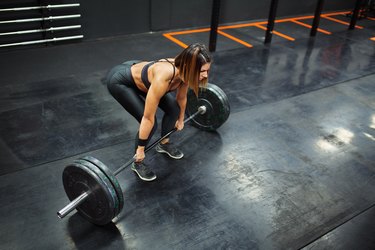
If you experience occasional pelvic pain after exercising, it's likely not a major cause for concern, as it's not unusual to have pain in your pelvis or abdomen after you work out, especially if you exercise hard. However, if you experience frequent pelvic pain after exercising, or your pain seems to be getting worse, see your physician for a diagnosis and to rule out any potentially serious causes.
Side Stitch or Cramp
Video of the Day
Most runners and other athletes who exercise vigorously have experienced a side stitch at some point. The pain from a side stitch can present mainly in your side, or it can radiate through your stomach and pelvis. The official name for this condition is exercise-related transient abdominal pain, or ETAP.
Video of the Day
According to a September 2014 paper published by Sports Medicine, consuming food or drink right before or during a workout is frequently linked to the development of ETAP. Although side stitches can feel extremely painful, they're not serious. If you think your pelvic pain after exercising stems from a side stitch or muscle cramp, massage the affected area hard with your hand until the cramping subsides.
Read more: Causes of Abdominal Pain and Fatigue
Gastrointestinal Pelvic Pain After Exercise
Many people who exercise, particularly runners and triathletes, experience some form of gastrointestinal issues during or after a long run or other workout session, according to a small study of 17 runners published by European Journal of Applied Physiology in October 2017_._ Flatulence, belching, nausea and even vomiting can appear together with pelvic pain or cramps.
In many cases, you can blame dehydration for your problems; although it's not clear why dehydration sparks pelvic pain after exercising along with other gastrointestinal issues, staying hydrated seems to solve the problem. Drink a glass of water about 30 minutes before your workout, and take water breaks during a longer exercise session.
Pelvic Pain and Endometriosis
Pelvic pain after a workout can be related to the menstrual cycle. Cramps are common before and sometimes during the menstrual period. Although exercise can help reduce period-related pain, severe conditions such as endometriosis can lead to pelvic pain after exercise.
Endometriosis causes the lining that normally grows inside the uterus to grow outside the uterus, according to Mayo Clinic. This condition usually causes increased menstrual pain and excessive bleeding.
Other Causes of Pelvic Pain
It's possible that your pelvic pain after exercising stems from an infected bladder or urinary tract, especially if you're also experiencing blood in your urine. If this is the case, see your physician to get a prescription for antibiotics. In addition, in some cases, menstrual cramps can cause pelvic pain after exercising, as can inflamed joints or a muscle strain. Your physician can help you determine if any of these issues are causing your pain.
If your pelvic pain after exercising continues to get worse, or if it's accompanied by gastrointestinal symptoms such as frequent diarrhea and bloating, consider testing for inflammatory bowel disease or celiac disease. Both can cause those symptoms. Definitely see your doctor if your pelvic pain after exercising doesn't resolve in a week or two.
- Sports Medicine: "Exercise-Related Transient Abdominal Pain (ETAP)"
- European Journal of Applied Physiology: "Exercise and gastrointestinal symptoms: running-induced changes in intestinal permeability and markers of gastrointestinal function in asymptomatic and symptomatic runners"
- Mayo Clinic: "Endometriosis"
Was this article helpful?
150 Characters Max
0/150
Thank you for sharing!
Thank you for your feedback!